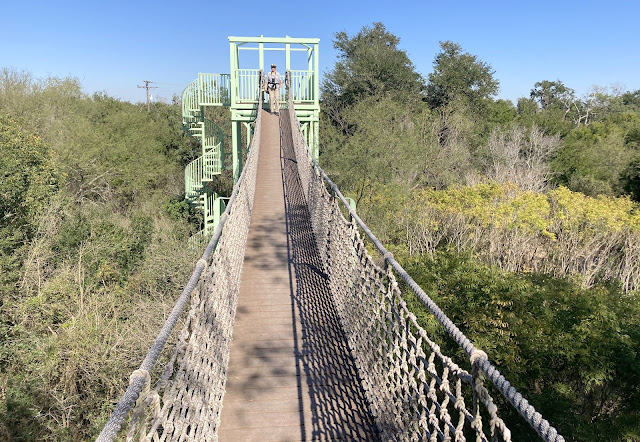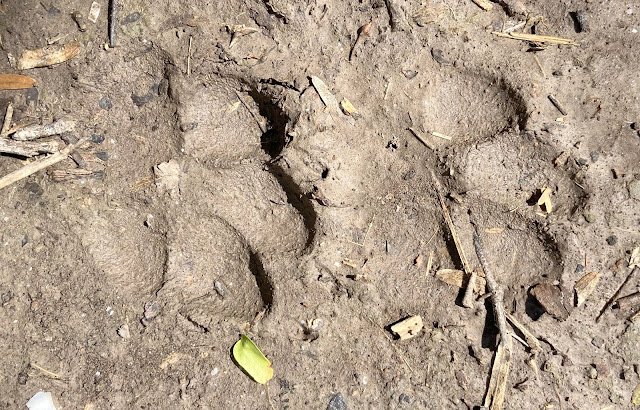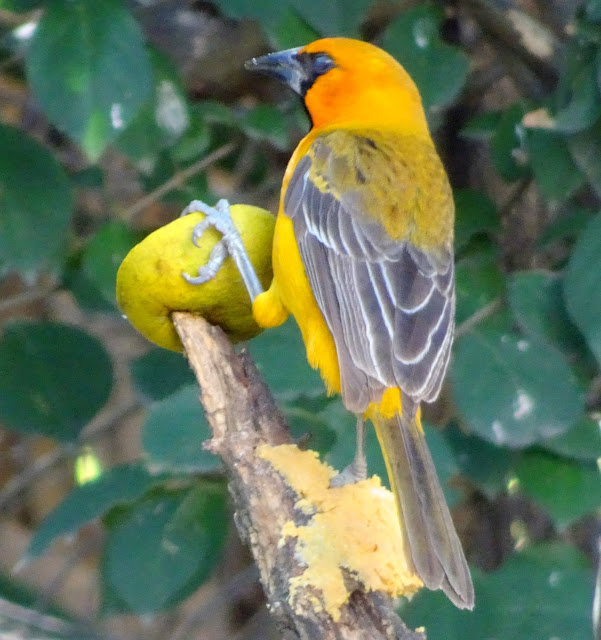We can stay very busy with the activities available at Bentsen Grove Resort. It is actually very hard to pull us away to do some local sight-seeing. But today we made the 26-mile drive to visit Santa Ana Wildlife Refuge. We've heard that a Bat Falcon has been spotted here this winter. In case you're like us and didn't know it, that's a bird that has never been seen before in the United States. When we googled "bat falcon," we found top stories in USA Today and Smithsonian Magazine and Fox News with headlines like "Bat falcon spotted in U.S. for the first time in history." This bird is making headlines, and we want to see it for ourselves. We are here to see the falcon, but we also love the Spanish-moss-draped trees that we found inside the refuge.
Thursday, March 10, 2022
The Bat Falcon - Never Seen Before in the U.S.!
Santa Ana Wildlife Refuge has 12 miles of trails, and we need some exercise. We took off on one of the dirt trails.
We probably should have thought through this decision. Considering that we have had a couple inches of rain lately, some of those dirt trails are now mud trails. Our shoes quickly became heavy as we plodded further up the trail.
We cleaned off some of that concrete-like mud because we didn't need that extra weight when we climbed the spiral staircase up to the tree-top suspension bridge.
From here we could see the tops of those Spanish-moss-draped trees around us--but not the bat falcon.
Our next climb was twice as high, as we went up the forty foot fire tower. We had a great view of the suspension bridge, but we didn't spot any wildlife yet in this wildlife refuge.
We crossed paths with the group that had started a guided bird tour several hours ago. These are serious birders! They have spotted over 40 different types of birds this morning, so maybe we're not looking in the right places. We got some advice from their leader, and then we started spotting some wildlife. We first pictured this long-billed thrasher in the tree . . .
and then this olive sparrow hiding in the shade. Obviously, neither is the bat falcon that we came to see.
Our next trail took us to the lake in the center of the refuge, so Denisa started taking pictures of water birds. But no bat falcon.
Then the ibis parade began. We saw the adult white ibis . . .
followed by the juvenile ibis still sporting its brown feathers.
Then a white-eyed ibis flew in to complete the ibis trifecta.
The three of them gave us a profile shot, all lined up like a wildlife museum display.
We know these bird names because we found Ken and Liz here today. What are the chances of being at the same lake within the same wildlife refuge at the same day at the same time with people that we met a couple weeks ago? They were the ones that sent a picture of us in our kayak at Choke Canyon State Park. Now they are staying in the Rio Grande Valley, hoping to check out the bat falcon. We were really surprised to see each other again!
Have we mentioned that we love the Spanish moss in this park?
Further down the trail, we found another group of birds gathered.
Floating among the herons standing in the shallows, were the ducks. We believe this is a male blue-winged teal duck.
We loved it when a flock of roseate spoonbills flew over and landed at our lake.
The rose-colored feathers and the unique spoon-shaped bill make getting a positive identification for a roseate spoonbill easy even for beginner birders like us.
We can also recognize a Northern Shoveler duck with its wide bill that helps it shovel up goodies from the lake. While they spend the summer in the north, the Northern Shovelers like spending the winter in places like south Texas. That reminds us of some people we know.
We could stay around this lake, but we still have many miles to hike in this large wildlife refuge. The mud on the trails firmed up as the sun came out this afternoon. But more than once we found foot prints in the fresh mud that indicated that not all the wildlife here has feathers. Pets aren't allowed, and this looks like bobcat prints in the mud from this morning.
Our trail opened up when we arrived at Cattail Lake. Based on the quantity and the size of the camera lenses, we think we might have found some more interesting wildlife.
Those cameras were not focused on this black-necked stilt feeding close to the edge of the lake.
We like their bright pink legs and stately tuxedo black and white plumage.
The cameras weren't pointed toward this little island in the lake. But it was fun to count all the different birds that were gathered here at a safe distance from all those birders.
We were most interested in the cinnamon teal ducks that were cruising the lake. Even though they are interesting, they aren't the bat falcon that we want to see.
It was about that time that one of those people with the big camera lenses announced, "He's back!" We all turned our attention to the area where those big lenses now were pointing. We were scanning the dead trees across the lake, until we finally could focus on the bird in the middle of the picture below. This is a special sighting because a bat falcon has never been seen before this one in the United States.
These pictures are the best we could do with our little camera with 40x zoom. We were glad that very experienced birders with high-powered scopes were happy to share their view. With the aid of the scope, we could clearly see this bat falcon that has wandered over the U.S. border to give us all a thrill. Through the scope, we watched as he ate his dinner. These birds are common in southern Mexico, Central America and South America, and we're not sure how this one stumbled so far north.
We heard that the bat falcon likes to hang out at Cattail Lake during the day, and he didn't disappoint us today. We also heard that he often makes an appearance around 6 p.m. on a telephone pole near the refuge entrance. We decided not to stay for that possibility, even though it would be a much closer picture. We thought this would be a two-hour walk through the refuge, and we've already been here twice that long. We were tired and very hungry by the time we made the 1.6-mile hike back to the entrance. We have hiked a total of 5.2 miles today, and our legs are unusually tired because we have also been standing for hours looking through binoculars. But Denisa couldn't help but stop by the bird feeders at the entrance of Santa Ana Wildlife Refuge. We got a close-up of an orange Altamira Oriole enjoying an orange. It's not the bat falcon, but we have been blessed with good weather and fun birding today! We can check the bat falcon off our list of birds that we had never heard of before--that have never been seen before in the United States.





























No comments:
Post a Comment